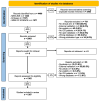Contribution of Open Access Databases to Intensive Care Medicine Research: Scoping Review
- PMID: 39787600
- PMCID: PMC11757948
- DOI: 10.2196/57263
Contribution of Open Access Databases to Intensive Care Medicine Research: Scoping Review
Abstract
Background: Intensive care units (ICUs) handle the most critical patients with a high risk of mortality. Due to those conditions, close monitoring is necessary and therefore, a large volume of data is collected. Collaborative ventures have enabled the emergence of large open access databases, leading to numerous publications in the field.
Objective: The aim of this scoping review is to identify the characteristics of studies using open access intensive care databases and to describe the contribution of these studies to intensive care research.
Methods: The research was conducted using 3 databases (PubMed-MEDLINE, Embase, and Web of Science) from the inception of each database to August 1, 2022. We included original articles based on 4 open databases of patients admitted to ICUs: Amsterdam University Medical Centers Database, eICU Collaborative Research Database, High time resolution ICU dataset, Medical Information Mart for Intensive Care (II to IV). A double-blinded screening for eligibility was performed, first on the title and abstract and subsequently on the full-text articles. Characteristics relating to publication journals, study design, and statistical analyses were extracted and analyzed.
Results: We observed a consistent increase in the number of publications from these databases since 2016. The Medical Information Mart for Intensive Care databases were the most frequently used. The highest contributions came from China and the United States, with 689 (52.7%) and 370 (28.3%) publications respectively. The median impact factor of publications was 3.8 (IQR 2.8-5.8). Topics related to cardiovascular and infectious diseases were predominant, accounting for 333 (25.5%) and 324 (24.8%) articles, respectively. Logistic regression emerged as the most commonly used statistical model for both inference and prediction questions, featuring in 396 (55.5%) and 281 (47.5%) studies, respectively. A majority of the inference studies yielded statistically significant results (84.0%). In prediction studies, area under the curve was the most frequent performance measure, with a median value of 0.840 (IQR 0.780-0.890).
Conclusions: The abundance of scientific outputs resulting from these databases, coupled with the diversity of topics addressed, highlight the importance of these databases as valuable resources for clinical research. This suggests their potential impact on clinical practice within intensive care settings. However, the quality and clinical relevance of these studies remains highly heterogeneous, with a majority of articles being published in low-impact factor journals.
Keywords: Amsterdam University Medical Centers Database; AmsterdamUMCdb; ICU; big data; database; databases; descriptive analysis; eICU Collaborative Research Database; eICU-CRD; intensive care unit; open access; screening.
©Julien Kallout, Antoine Lamer, Julien Grosjean, Gaétan Kerdelhué, Guillaume Bouzillé, Thomas Clavier, Benjamin Popoff. Originally published in the Journal of Medical Internet Research (https://www.jmir.org), 09.01.2025.
Conflict of interest statement
Conflicts of Interest: None declared.
Figures



References
-
- Sanchez-Pinto LN, Luo Y, Churpek MM. Big data and data science in critical care. Chest. 2018;154(5):1239–1248. doi: 10.1016/j.chest.2018.04.037. https://europepmc.org/abstract/MED/29752973 S0012-3692(18)30725-6 - DOI - PMC - PubMed
-
- Safran C, Bloomrosen M, Hammond WE, Labkoff S, Markel-Fox S, Tang PC, Detmer DE. Toward a national framework for the secondary use of health data: an American medical informatics association white paper. J Am Med Inform Assoc. 2007;14(1):1–9. doi: 10.1197/jamia.M2273. https://europepmc.org/abstract/MED/17077452 M2273 - DOI - PMC - PubMed
-
- Sidey-Gibbons JAM, Sidey-Gibbons CJ. Machine learning in medicine: a practical introduction. BMC Med Res Methodol. 2019;19(1):64. doi: 10.1186/s12874-019-0681-4. https://bmcmedresmethodol.biomedcentral.com/articles/10.1186/s12874-019-... 10.1186/s12874-019-0681-4 - DOI - DOI - PMC - PubMed
-
- Chiolero A, Buckeridge D. Glossary for public health surveillance in the age of data science. J Epidemiol Community Health. 2020;74(7):612–616. doi: 10.1136/jech-2018-211654. https://boris.unibe.ch/id/eprint/143766 jech-2018-211654 - DOI - PMC - PubMed
Publication types
MeSH terms
LinkOut - more resources
Full Text Sources
Medical

